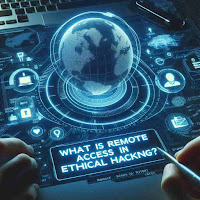Remote access in ethical hacking means connecting to and controlling a computer or network from a faraway place. Ethical hackers, also known as white hat hackers, use remote access to find and fix security problems in systems. This is important to keep systems safe from bad hackers who want to steal information or cause damage. In this blog post, we'll talk about what remote access is, the tools and methods used, and why it's so important in ethical hacking.
Understanding Remote Access
Remote access lets people connect to a computer or network over the internet or another network. This allows them to do tasks, fix problems, and manage systems without being in the same place as the computer or network. Remote access is made possible through special tools and protocols that ensure the connection is secure and efficient.
Key Tools and Methods for Remote Access
Ethical hackers use various tools and methods for remote access. Each tool has its own features and uses. Here are some of the most common ones:
Remote Desktop Protocol (RDP)
- What it is: A protocol developed by Microsoft that allows remote access to Windows computers.
- How it works: Provides a graphical interface for users to connect to and control a remote computer.
- Why it’s used: It’s commonly used for remote work and support.
Secure Shell (SSH)
- What it is: A protocol used for secure remote access to Unix-based systems.
- How it works: Encrypts the connection to ensure data remains confidential.
- Why it’s used: It’s popular for remote server management because of its security features.
Virtual Network Computing (VNC)
- What it is: A graphical desktop-sharing system that uses the Remote Frame Buffer (RFB) protocol.
- How it works: Allows users to control another computer remotely by sharing its desktop.
- Why it’s used: It’s used for remote technical support and access to desktops.
TeamViewer
- What it is: A tool for remote support and access.
- How it works: Offers features like file transfer, screen sharing, and session recording.
- Why it’s used: It’s user-friendly and widely used for remote support.
AnyDesk
- What it is: Another remote desktop software similar to TeamViewer.
- How it works: Provides secure and fast remote access with features like file transfer and remote printing.
- Why it’s used: It’s known for its speed and reliability.
Related Posts
Ethical Hacking Applications of Remote Access
Ethical hackers use remote access for many different tasks. Here are some of the main applications:
Vulnerability Assessment
- What it is: Checking systems for security weaknesses.
- How it works: Ethical hackers use remote access to scan and test systems from afar.
- Why it’s important: Helps find and fix problems before bad hackers can exploit them.
Penetration Testing
- What it is: Simulating attacks to test system defenses.
- How it works: Ethical hackers use remote access tools to simulate attacks from outside the network.
- Why it’s important: Helps organizations understand how well their defenses work against real attacks.
Incident Response
- What it is: Responding to security breaches quickly.
- How it works: Ethical hackers use remote access to investigate and respond to attacks.
- Why it’s important: Helps minimize damage and recover quickly from attacks.
Security Management
- What it is: Ongoing monitoring and management of systems.
- How it works: Ethical hackers use remote access to perform updates, apply patches, and enforce security policies.
- Why it’s important: Keeps systems secure and up-to-date.
Importance of Secure Remote Access
Using remote access is powerful, but it can be risky if not done securely. Ethical hackers follow best practices to make sure remote access is safe:
Strong Authentication
- What it is: Verifying the identity of users accessing systems remotely.
- How it works: Implementing multi-factor authentication (MFA), which requires multiple forms of verification.
- Why it’s important: Ensures that only authorized users can access the system.
Encryption
- What it is: Protecting data transmitted over remote connections.
- How it works: Using encryption protocols like SSL/TLS to secure the data.
- Why it’s important: Prevents unauthorized access to sensitive information.
Access Control
- What it is: Limiting who can access systems remotely.
- How it works: Using role-based access controls to restrict permissions to only those who need them.
- Why it’s important: Reduces the risk of unauthorized access.
Regular Audits
- What it is: Checking systems and remote access logs regularly.
- How it works: Conducting security audits to detect and respond to any suspicious activities.
- Why it’s important: Helps maintain security and identify potential issues early.
Conclusion
Remote access is a crucial part of ethical hacking. It allows ethical hackers to secure and manage systems effectively from any location. By understanding and using secure remote access techniques, ethical hackers can protect organizations from cyber threats and ensure the safety of their digital assets. Always remember to use remote access tools ethically and follow legal and organizational guidelines.
Remote access is a powerful tool in the hands of ethical hackers, providing them with the means to keep systems safe, respond to incidents quickly, and ensure ongoing security management. By following best practices and staying informed about the latest tools and methods, ethical hackers can effectively safeguard systems and networks from potential threats.

